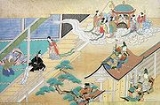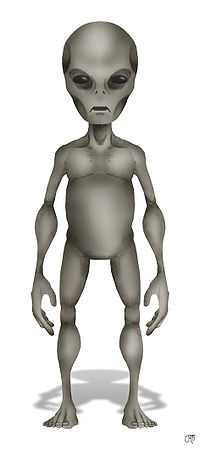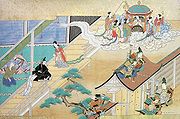
Extraterrestrial life in popular culture
Encyclopedia

Popular culture
Popular culture is the totality of ideas, perspectives, attitudes, memes, images and other phenomena that are deemed preferred per an informal consensus within the mainstream of a given culture, especially Western culture of the early to mid 20th century and the emerging global mainstream of the...
s, "extraterrestrials" are life forms — especially intelligent life forms— that are of extraterrestrial origin
Extraterrestrial life
Extraterrestrial life is defined as life that does not originate from Earth...
(often also called "aliens").
Historical ideas

Pre-modern
Cosmic pluralismCosmic pluralism
Cosmic pluralism, the plurality of worlds, or simply pluralism, describes the belief in numerous other worlds which harbour extraterrestrial life. The debate over pluralism began as early as the time of Thales Cosmic pluralism, the plurality of worlds, or simply pluralism, describes the belief in...
, the assumption that there are many inhabited worlds beyond the human sphere predates modernity and the development of the heliocentric model and is common in mythologies worldwide. The 1st century writer of satires Lucian in his True History
True History
True History or True Story is a travel tale by the Greek-speaking Syrian author Lucian of Samosata, the earliest known fiction about travelling to outer space, alien life-forms and interplanetary warfare. Written in the 2nd century, the novel has been referred to as "the first known text that...
claims to have visited the moon when his ship was sent up by a fountain, which was peopled and at war with the people of the Sun over colonisation of the Morning Star. Other worlds are depicted in such early works as the 10th-century Japanese narrative, The Tale of the Bamboo Cutter
The Tale of the Bamboo Cutter
, also known as , is a 10th century Japanese folktale. It is considered the oldest extant Japanese narrative and an early example of proto-science fiction....
, and the medieval Arabic The Adventures of Bulukiya (from the One Thousand and One Nights).
Early modern
The assumption of extraterrestrial life in the narrow sense (as opposed to generic cosmic pluralism) becomes possible with the development of the heliocentric understanding of the solar systemSolar System
The Solar System consists of the Sun and the astronomical objects gravitationally bound in orbit around it, all of which formed from the collapse of a giant molecular cloud approximately 4.6 billion years ago. The vast majority of the system's mass is in the Sun...
, and later the understanding of interstellar space, during the Early Modern period
Early modern period
In history, the early modern period of modern history follows the late Middle Ages. Although the chronological limits of the period are open to debate, the timeframe spans the period after the late portion of the Middle Ages through the beginning of the Age of Revolutions...
, and the topic was popular in the literature of the 17th and 18th century.
The didactic poet Henry More
Henry More
Henry More FRS was an English philosopher of the Cambridge Platonist school.-Biography:Henry was born at Grantham and was schooled at The King's School, Grantham and at Eton College...
took up the classical theme of Cosmic pluralism
Cosmic pluralism
Cosmic pluralism, the plurality of worlds, or simply pluralism, describes the belief in numerous other worlds which harbour extraterrestrial life. The debate over pluralism began as early as the time of Thales Cosmic pluralism, the plurality of worlds, or simply pluralism, describes the belief in...
of the Greek Democritus
Democritus
Democritus was an Ancient Greek philosopher born in Abdera, Thrace, Greece. He was an influential pre-Socratic philosopher and pupil of Leucippus, who formulated an atomic theory for the cosmos....
in "Democritus Platonissans, or an Essay Upon the Infinity of Worlds" (1647). With the new relative viewpoint that understood "our world's sunne / Becomes a starre elsewhere", More made the speculative leap to extrasolar planets,
- the frigid spheres that 'bout them fare;
- Which of themselves quite dead and barren are,
- But by the wakening warmth of kindly dayes,
- And the sweet dewie nights, in due course raise
- Long hidden shapes and life, to their great Maker's praise.
The possibility of extraterrestrial life was a commonplace of educated discourse in the 17th century, though in Paradise Lost
Paradise Lost
Paradise Lost is an epic poem in blank verse by the 17th-century English poet John Milton. It was originally published in 1667 in ten books, with a total of over ten thousand individual lines of verse...
(1667) John Milton
John Milton
John Milton was an English poet, polemicist, a scholarly man of letters, and a civil servant for the Commonwealth of England under Oliver Cromwell...
cautiously employed the conditional when the angel suggests to Adam the possibility of life on the Moon:
- Her spots thou seest
- As clouds, and clouds may rain, and rain produce
- Fruits in her softened soil, for some to eat
- Allotted there; and other Suns, perhaps,
- With their attendant Moons, thou wilt descry,
- Communicating male and female light,
- Which two great sexes animate the World,
- Stored in each Orb perhaps with some that live
Fontanelle
Bernard le Bovier de Fontenelle
Bernard Le Bovier de Fontenelle , also called Bernard Le Bouyer de Fontenelle, was a French author.Fontenelle was born in Rouen, France and died in Paris just one month before his 100th birthday. His mother was the sister of great French dramatists Pierre and Thomas Corneille...
's "Conversations on the Plurality of Worlds
Conversations on the Plurality of Worlds
Conversations on the Plurality of Worlds is a popular science book by French author Bernard le Bovier de Fontenelle, published in 1686. It offered an explanation of the heliocentric model of the Universe, suggested by Nicolaus Copernicus in his 1543 work De revolutionibus orbium coelestium...
" with its similar excursions on the possibility of extraterrestrial life, expanding rather than denying the creative sphere of a Maker, was translated into English in 1686. In "The Excursion" (1728) David Mallet exclaimed, "Ten thousand worlds blaze forth; each with his train/Of peopled worlds."
See also
- Alien invasionAlien invasionThe alien invasion is a common theme in science fiction stories and film, in which extraterrestrial life invades Earth either to exterminate and supplant human life, enslave it under a colonial system, harvest humans for food, steal the planet's resources, or destroy the planet altogether.The...
- List of fictional extraterrestrials
- List of films featuring extraterrestrials
Further reading
- Roth, Christopher F., "Ufology as Anthropology: Race, Extraterrestrials, and the Occult." In E.T. Culture: Anthropology in Outerspaces, ed. by Debbora Battaglia. Durham, N.C.: Duke University Press, 2005.
- Sagan, CarlCarl SaganCarl Edward Sagan was an American astronomer, astrophysicist, cosmologist, author, science popularizer and science communicator in astronomy and natural sciences. He published more than 600 scientific papers and articles and was author, co-author or editor of more than 20 books...
. 1996. The Demon-Haunted World: Science as a Candle in the Dark: chapter 4: "Aliens"
External links
- UFO occupants - grey and reptilian alien pictures
- ufologie.net - The Filiberto Caponi close encounter of the 3rd kind, 1993
- ufocasebook.com - Filiberto Caponi Close Encounter 1993
- The Ilkley Moor encounter of the 3rd kind, 1987
- UFO Magazine UK and Discussion Forum
- http://www.iitr.ernet.in/departments/CE/people/faculty/facthtml/ashokfce.htm
- Best Use of Aliens As Metaphor

